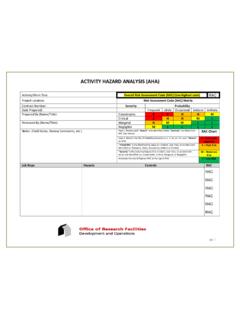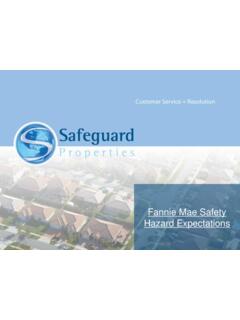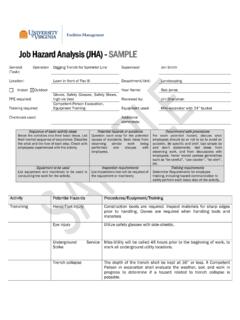Transcription of Hazard Prevention and Control After hazards are identified, …
1 Hazard Prevention and Control After hazards are identified, how can they be prevented and controlled? Continually review the farmstead, shop areas and work practices to Control or prevent workplace hazards . Some ways to prevent and Control hazards are: Regularly and thoroughly maintain equipment Ensure that Hazard correction procedures are in place Ensure that everyone knows how to use and maintain personal protective equipment Make sure that everyone understands and follows safe work procedures After detection, all current and potential hazards must be prevented, corrected or controlled. Systems used to prevent and Control hazards include: Engineering Controls Administrative Controls Personal Protective Equipment (PPE) Systems to Track Hazard Correction Preventive Maintenance Systems Emergency Preparation Engineering Controls The first and best strategy is to Control the Hazard at its source.
2 Engineering controls do this, unlike other controls that generally focus on the employee exposed to the Hazard . The basic concept behind engineering controls is that, to the extent feasible, the work environment and the job itself should be designed to eliminate hazards or reduce exposure to hazards . Engineering controls can be simple in some cases. They are based on the following principles: If feasible, design the facility, equipment, or process to remove the Hazard or substitute something that is not hazardous. If removal is not feasible, enclose the Hazard to prevent exposure in normal operations. Where complete enclosure is not feasible, establish barriers or local ventilation to reduce exposure to the Hazard in normal operations. Administrative Controls While safe work practices can be considered forms of administrative controls, OSHA uses the term administrative controls to mean other measures aimed at reducing employee exposure to hazards .
3 These measures include additional relief workers, exercise breaks and rotation of workers. These types of controls are normally used in conjunction with other controls that more directly prevent or Control exposure to the Hazard . Personal Protective Equipment (PPE) When exposure to hazards cannot be engineered completely out of normal operations or maintenance work, and when safe work practices and other forms of administrative controls cannot provide sufficient additional protection, a supplementary method of Control is the use of protective clothing or equipment. This is collectively called personal protective equipment, or PPE. PPE may also be appropriate for controlling hazards while engineering and work practice controls are being installed. PPE Hazard Assessment and TrainingThe basic element of any management program for PPE should be an in depth evaluation of the equipment needed to protect against the hazards at the workplace.
4 The evaluation should be used to set a standard operating procedure for personnel, then train employees on the protective limitations of the PPE, and on its proper use and maintenance. Using PPE requires Hazard awareness and training on the part of the user. Employees must be aware that the equipment does not eliminate the Hazard . If the equipment fails, exposure will occur. To reduce the possibility of failure, equipment must be properly fitted and maintained in a clean and serviceable condition. Systems to Track Hazard Correction An essential part of any safety and health system is the correction of hazards that occur despite the overall Prevention and Control program. For larger sites, documentation is important so that management and employees have a record of the correction. Many companies use the form that documents the original discovery of a Hazard to track its correction.
5 Hazard correction information can be noted on an inspection report next to the Hazard description. Employee reports of hazards and reports of accident investigation should provide space for notations about Hazard correction. Preventive Maintenance Systems Good preventive maintenance plays a major role in ensuring that Hazard controls continue to function effectively. It also keeps new hazards from arising due to equipment malfunction. Reliable scheduling and documentation of maintenance activity is necessary. The scheduling depends on knowledge of what needs maintenance and how often. The point of preventive maintenance is to get the work done before repairs or replacement is needed. Documentation is not only a good idea, but is a necessity. Certain OSHA standards also require that preventive maintenance be done.
6 Emergency Preparation During emergencies, hazards appear that normally are not found in the workplace. These may be the result of natural causes (floods, tornadoes, etc.), events caused by humans but beyond Control (train or plane accidents, terrorist activities, etc.), or within a farm s own systems due to unforeseen circumstances or events. You must become aware of possible emergencies and plan the best way to Control or prevent the hazards they present. Some of the steps in emergency planning include: Survey of possible emergencies; Planning actions to reduce impact on the workplace; Employee information, training, and drills as needed















